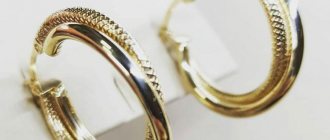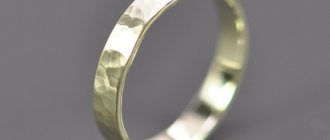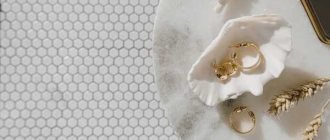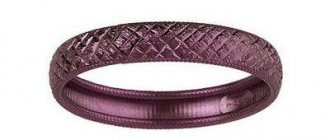Diamond, one of the most sought-after stones in jewelry production, has been subjected to all sorts of cuts over many centuries of use, the most luxurious settings have been selected for it, and combinations with other precious stones have been tried.
It would seem that there can be no talk of any innovative technologies in the field of diamond processing and framing.
However, 7 years ago a dancing diamond appeared - a brilliant invention that became a real breakthrough in the art of making jewelry from shining crystals.
What is a dancing diamond?
A “dancing” diamond is a gemstone that has been specially cut to give it a cross-shaped shine and is set in a piece in a special way that allows it to balance on two supports, moving with the breeze or a barely noticeable sigh.
Why is it called that?
Since 2012, the term “dancing diamond” has been used to designate a new type of jewelry in which the stones are in constant dynamics due to the special design of the frames.
In these products, the dazzling shine of diamonds, endowed with the ability to repeatedly refract rays of light passing through them, is enhanced by the non-stop vibration of crystals that react to even the slightest body movement.
It is this dazzling light extravaganza that is called “dance”.
History of creation
For several centuries, diamonds in jewelry, attached in a hard or semi-hard way, showed their natural properties either in bright light or with the help of active movements of their owner.
Japanese jeweler Hidetaka Dobashi, who owns his own jewelry company founded in 1980, set out to improve jewelry in such a way that the optical effects inherent in diamonds were maximized, and everyone present could fully enjoy the beauty of the shining crystals.
After many years of studying gemology, Hidetaka Dobashi invented and patented an original cutting method in 1999, in which the 46 facets of a diamond emit a bright cross-shaped glow.
In 2010, the master, who thoroughly studied all the intricacies of light refraction in diamonds and other transparent stones (his area of specialization was previously rubies and sapphires), began to develop a special mount, thanks to which the crystals could “dance”, demonstrating a unique play of light.
The intense work, during which several dozen diamonds were irreparably damaged (the fastening, which seemed very simple, did not want to work properly), continued for two years.
Hidetaka Dobashi presented the first batch of jewelry with dancing diamonds (this was only a small part of the collection, consisting of a dozen pendants and earrings) to the public at a jewelry exhibition in Hong Kong in June 2012.
The constantly moving and seemingly living stones, scattering whole sheaves of dazzling sparks, oddly enough, did not make much of an impression on the visitors of the exhibition that time.
However, three months later, at the same exhibition in Hong Kong, Hidetaka Dobashi presented the “Dancing Stones” collection, consisting of 150 products and having a stunning success. Earrings, pendants, pendants and rings with floating crystals were appreciated.
The author of the original products received many orders and entered into dozens of agreements with investors who wanted to cooperate with his jewelry company.
A year after the landmark exhibition, Hidetaka Dobashi received an international patent for the frame he invented, valid in the United States of America, Europe, India and China.
Interest in jewelry with dancing crystals has not faded to this day. The jewelry company owned by Mr. Dobashi issues patent licenses to any companies that create jewelry from loose stones.
Construction device
In order to understand the essence of the invention of master Hidetaka Dobashi, you need to know about two traditional methods of fixing stones in jewelry: hard and semi-rigid:
- Rigidly fixed crystals can only move with the product itself. For example, in order for a diamond inserted into a ring to sparkle with all its facets, its owner must move her hand.
- In products with semi-rigid fastening (as a rule, these are earrings and pendants), the frame of the stones is fixed at one specific point. As a result, when the owner of the jewelry moves, the stones begin to make oscillatory movements, which soon die out.
The invention of the Japanese master consisted of a fundamentally new method of fixing crystals, in which a stone attached to two movable supports even reacts to the heartbeat of its owner.
This unique effect is especially noticeable when wearing dancing crystal pendants, which are known to be worn on the chest.
The setting of stones, developed by a Japanese jeweler, is reliable and amazingly simple. The dancing diamonds in this type of jewelry are placed in a special setting, the left and right sides of which are spot soldered to the back of the jewelry.
Thanks to a precisely adjusted balance, the dancing crystal, in response to even a barely noticeable movement (including breathing) of the owner of the product, begins to perform pendulum-like swaying movements, which, contributing to the appearance of a large number of glares, increase the number of refracted rays.
As a result, a person admiring the play of light in a crystal has the feeling that it is shining continuously.
To ensure that the dancing diamond does not touch the clothes or body of its owner, the reverse side of the product is covered with a special element that helps ensure that the spectacular “dance” of the crystal lasts as long as possible.
The frame of the first products with dancing crystals (which, by the way, can be not only cut diamonds, but also other transparent minerals) was made of yellow gold. Nowadays, any noble metals are used for its manufacture, including platinum and silver.
In conclusion, I would like to note that the setting of exclusive jewelry in no way affects the quality of the crystals it holds (it is worth recalling that well-cut, high-quality stones are used as dancers: only in this case the play of light will emphasize their purity).
If desired, they can be removed from the frame at any time and used to make another piece of jewelry.
What is the invention
In order to understand how the innovation invented by Mr. Dobashi is expressed, let’s first consider how traditional gems are attached. There are only two ways.
Rigid fixation of the stone in the decoration. With this method, the stone can only move together with the entire decoration. For example, a diamond ring. The stone is fixed at one point, “suspended”. This mount is used for pendants and earrings. If the jewelry sways when the owner moves, then the stone sways, but such vibrations quickly die out.
Hidetaka Dobashi's invention is aimed precisely at ensuring that the slightest movement - even a sigh - causes the diamond to vibrate, although the jewelry itself is not particularly affected. He managed to achieve this through an unusual fastening design - the stone in it is limited to two points of contact. Due to this, he literally comes to life, plays, “dances.”
Properties of dancing crystals
People have known since time immemorial that diamonds are endowed with many healing properties. Many handwritten treatises are devoted to this topic.
According to gemologists, with the help of dancing crystals one can treat mental disorders and diseases of the nervous system, and also use them in the fight against:
- drug addiction;
- alcoholism;
- insomnia;
- sclerosis;
- depressive states;
- all kinds of stress and phobias.
In addition, lithotherapists use dancing diamonds for:
- treatment of skin diseases;
- improving the functioning of the digestive organs;
- treatment of diseases of the musculoskeletal system and upper respiratory tract;
- strengthening the immune system.
It should be taken into account that when treating serious illnesses, the healing power of dancing diamonds should be used as part of complex therapy, which prescribes the mandatory use of medications prescribed by a qualified specialist.
However, the very fact of presenting jewelry with a dancing diamond can not only improve the mood of any representative of the fair sex, but also make her feel happier.
Dancing (sometimes called floating) diamonds, virtually free of flaws, are suitable for women of any age. You will have to get used to their non-stop flickering.
If the expressive play of continuously dancing crystals causes irritation, it is better to refuse to purchase such jewelry.
Which gold to choose
Few people have thought about what a gold sample is and why it looks like that. What you can see in jewelry stores is gold alloy. Pure gold is not practical, it is a very soft metal, so the alloy contains metals such as copper, platinum, nickel, silver, palladium. The gold sample on a product indicates the qualitative and quantitative composition.
In Russia, the Metric standard system is used to designate gold. It means how many grams of gold are contained in 1000 grams of the alloy. For example, 585 standard means there are 585 grams of yellow metal in it. Everything is quite simple.
But abroad, the Karat system of samples is used. The alloy is divided into 24 parts. Carat is one part out of 24. If it is said that a product is 18 carats, then this means that out of 24 parts of the alloy, 18 are actually gold, and the remaining 6 parts are other metals. For clarity, let's look at a comparative table of the Metric and Carat standards.
Metric Carat Percentage of pure gold / Other metals
- 375 9 37.5 Silver, copper.
- 500 12 50 Silver, copper.
- 583 14 58.3 Silver, copper, nickel, palladium.
- 585 14 58.5 Silver, copper, nickel, palladium.
- 750 18 75 Silver, platinum, copper, nickel, palladium.
- 958 23 95,8
- 999 24 99,9
Depending on the metal, the alloy can become of different colors - white, pink, yellow, green.
Prices
In the catalog of a network of jewelry stores, prices for jewelry from the “Dancing Diamond Air” collection are as follows:
- ring – from 58,000 rubles;
- suspension – from 34,000 rubles;
- bracelet – from 160,000 rubles;
- earrings – from RUB 73,000;
- necklace – from RUB 39,000;
- studs – from 76,000 rub.
The cost of the products depends on the number of stones used, their dimensions, weight and what metal is used to make the frame (white, yellow or red gold).
The cost of jewelry made to order is calculated individually.
When purchasing jewelry, each crystal must be examined with a magnifying glass to make sure there are no small cracks, chips, scratches or unwanted inclusions.
Where else to buy?
Citizens of the Russian Federation can purchase products with dancing diamonds:
- In a chain of retail stores owned by .
- In one of the 140 jewelry stores of the “Lines of Love” network, located in sixty cities of Russia, which are official representatives of jewelry (Kostroma).
- In the online store "Moscow Jewelry Factory".
- In branded sections (they are available in almost all major jewelry stores) or in Sokolov flagship stores. This brand also has an official online store.
- In the Adamas chain of jewelry stores.
- B (there are more than 350 of them in Russia).
The technology for making jewelry with dancing crystals is not a secret development and is widely used by jewelers all over the world. Similar products from the famous Italian brand Roberto Bravo are very popular among Hollywood movie stars.
In Russia, the production of jewelry of this type is carried out by:
- Bronnitsky Jewelry Factory.
- Jewelry, located in the Kostroma region (its products are known on the market under the Sokolov brand).
- Muz (Moscow jewelry factory).
Is it worth buying?
The answer to this question should be based on personal preference:
- Jewelry with dancing diamonds, mesmerizing with the beauty of their enchanting radiance, is ideal for extravagant ladies who love to be the center of everyone's attention.
- Modest girls who prefer stones that emit a muted soft glow are better off opting for classic pieces.
Customers' opinions
A dancing diamond, according to many buyers, is a very unusual piece of jewelry. If you want to surprise a loved one with something, then this is the most suitable option. Of course, the prices for such jewelry are higher than usual, but the quality of the stones used is worth it. Some people find the constant rocking of the pebble annoying and may even worry that it will slip out, but this is not the case.
The fastenings are made inside the frame, and correctly calculated balancing does not allow the stone to fall out.
Those who like the exoticism of an unusual design note its attractive properties of “sprinkling” sparks around itself and shimmering with all the colors of the rainbow at the slightest vibration. In any case, such a gift is unlikely to leave anyone indifferent.
How to wear?
- Jewelry with dancing diamonds (especially earrings and pendants), mesmerizing with the iridescent shimmer of crystals exclusively in evening light, is appropriate only in combination with expensive evening dresses. They are completely unsuitable for creating everyday images, since in everyday life and in daylight, stones that have lost their dazzling shine can be mistaken for ordinary jewelry.
- Accessories with dancing crystals can be worn on a romantic date, private party, social event or business dinner.
- Stones that are in constant motion look best when set in yellow or white gold.
- Any item with dancing crystals is considered to be an ideal engagement gift.
Keychain - a brother of the pendant
Dancing Diamond
The most common way to wear a pendant is as a pendant. This decoration is worn on the chest, as if it protects the heart, the source of vitality. This applies no less to brooches.
Depending on the shape, there are the following types of pendants:
- Religious attributes, crosses, icons, crescents, other religious symbols.
- Romantic symbolism, one or two hearts, double rings, butterflies, angels.
- Zodiac signs.
- Letter symbols, Chinese and Japanese characters.
- Geometric shapes: squares, ovals, circles, drops, triangles.
- Flower figurines and many others.
There are always restrictions and requirements in the production of jewelry: rings must be comfortable to wear, earrings must be light, bracelets must be symmetrical, and only pendants have freedom for development and creativity.
Interesting about the topic: Features of the stone - ruby
Reviews
Reviews from customers who own jewelry with dancing stones are full of rave reviews.
The advantages of these products, in their opinion, are:
- The ability to emit continuous flickering as a result of imperceptible impulses (for example, during breathing and even rapid heartbeat) emanating from their owners. As a result, the owners of exquisite jewelry, emitting cascades of dazzling flashes, find themselves in the center of admiring attention from others.
- The highest quality (manifested in the impeccable coloring and ideal purity of the stones) and the impeccable cut of the diamonds used to make jewelry.
- In the extraordinary reliability of fastening the stones, “dancing” in an almost imperceptible frame.
The number of people who do not share the enthusiasm of fans of a fashionable novelty is very small. From their point of view, continuously twitching crystals emitting a trembling glow cause nothing but irritation.
Gold pendant
The most popular gold standard in Russia is 585 (14 carats), while 750 (18 carats) is valued abroad. There is no need to rush to conclusions that the second test is better. The 750 alloy contains 3⁄4 gold, so it is chemically more resistant, but at the same time it is much softer than 585, and it is easier to get scratches on it. Many impurities make 585 sample not only cheaper, but also wear-resistant. The previously produced 583 standard was replaced by 585, as it corresponded to the 14 carat gold component.
Hallmarks 958 and 999 are not used in jewelry. White gold alloy is made using white metals such as nickel, platinum and palladium. When using silver, the alloy is also white, but with a matte sheen.
It should be noted that diamond jewelry attracts attention only if each diamond is of a certain quality. Crystals with a clarity rating of 3 are considered beautiful diamonds. This means that the diamond has no more than 2-3 small light inclusions.
Modern attitudes and values make pendants with precious stones favorite jewelry and desired gifts for almost everyone living on earth.
Other Dancing Diamond Settings
The term “dancing diamond” can only be used in relation to products made in accordance with the technology developed by the master Hidetaka Dobashi, however, recently, under the guise of “dancing”, sellers often offer jewelry (earrings and pendants) in which stones are rigidly attached to movable suspension fixed separately.
This long-known and widespread method has nothing to do with dancing crystals.
Not long ago, jewelers began to practice the technique of setting dancing diamonds without using any settings.
Having made a through hole in the crystal using a laser, they insert the thinnest platinum wire into it, thanks to which the diamond, like a bead hanging on a fishing line, acquires the ability to rotate and flicker, reflecting the light falling on it.
This method also does not make the stone dance, since partial contact with the wearer’s clothing and body deprives it of the effect of continuous radiance.
Despite its external effectiveness, this technique, associated with irreversible damage and - in connection with this - a reduction in the cost of the dancing crystal, has not become widespread.
History of pendants
No one in the world has yet undertaken to calculate how many years people have been using pendants for jewelry. At the dawn of mankind, pendants looked like teeth, bones, pebbles, tails, pieces of wood, and were not essentially decorations. They were amulets and talismans for protection from evil spirits, accidents, and diseases.
With the development of civilization, pendants became more and more sophisticated. Their heyday began in Ancient Egypt. There the decorations took on the appearance of gods. Even in the tomb of Tutankhamun, a gold pendant in the shape of a scarab beetle was found.
Pendants, including those with diamonds, became really widespread in the Middle Ages. Even the word itself was born in France at this time. Order pendants and insignia decorated with diamonds appeared. Pendants and medallions appeared in which mini-portraits, strands of hair, and native land could be stored. Sometimes these were perfume bottles or poison containers, which were especially popular during the time of Catherine de Medici.
Modern pendants are real works of art; they have begun to be used on bracelets and on favorite things, for example, on a phone or as a keychain.










